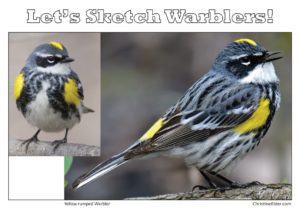Warbler Sketching Workshop
Watch the video below to learn all about the warbler family of birds. In the second half I will lead you through a step-by-step demonstration of drawing a Yellow-rumped Warbler. CLICK HERE to download your Yellow-rumped Warbler image to follow along.
CLICK HERE to download your Yellow-rumped Warbler image to follow along (as seen below)
How to sketch an Ovenbird
The 2-minute video below shows you my technique for sketching an Ovenbird. This species is stockier than most warblers, looking a bit more like a sparrow than your average warbler, but the basic body plan is the same. To learn more about Ovenbirds visit the Cornell Lab of Ornithology website.
Follow along with a pencil and paper, pausing the video as needed. In the video I mention some parts of the anatomy, so you may want to download my Parts of a Bird Cheat Sheet.
Things to notice when sketching a warbler for identification purposes
Most warblers have a similar body size and shape with a fairly short and slender bill. So your challenge is to notice what is different about them, which mostly comes down to color and behavior. Learning to identify warblers in the field can be a challenge with their skulky behavior and often densely forested habitats. I recommend packing a sketchbook with your binoculars next time you’re out bird watching and the rewards will be many.
Coloration and color patterns: Warblers come in two basic varieties; one type is relatively plain brown with some subtle streaking (like ovenbirds and waterthrushes) and the other type is brightly colored and patterned, with varying amounts of yellow, red, blue, white and/or black (like the Prothonotary Warbler or the Black-throated Blue Warbler). Also look for the following:
- An eye ring, its color, and whether it is complete or broken
- Stripes around eye; either through, above, or below the eye
- Patches of color on the cheeks or rump and their color
- Stripes or streaking on the throat or breast
- Wing bars and their color
- Underparts (since that’s the only view you’ll often get of many species who flit quickly about in the treetops!). Notice the colors and patterns on their breast, belly, sides and undertail coverts.
Anatomy:
- Overall size and shape of body and bill
- Primary projection (the length of the primaries beyond the tips of the secondaries)
- Length of tail, and its length beyond the end of the primaries and beyond the end of the coverts
Behavior: (if you find that ‘drawing’ behavior is a challenge, then simply jot down some written notes in the margins of your sketchbook)
- Is your warbler foraging in the trees or on the ground?
- Does it fan its tail, spread its wings, bob or ‘wag’ its tail?
- What angle does the bird hold its tail in relation to its body?
- Is the bird’s gait hopping, walking or shuffling?
- Character of its voice; the male’s song and the call and flight notes of both sexes
Learn more about warblers and how to identify them
*If you’d like to learn more about warblers and how to identify them, check out my post on Identifying Warblers.
If you need some recommendations on art supplies, see this comprehensive list of my favorite drawing and painting materials.
![]()
Did You Enjoy This Story?
If you’ve found value in this story and believe in my mission to educate youth and adults alike on the value of nature, I invite you to make a donation to help broaden and deepen the work I can accomplish.
Click the Paypal ‘Donate’ button below to donate any amount you wish to support the conservation and education work I do. You don’t need to have a Paypal account to donate, you may also choose to use a credit card, or simply send put a check in the mailbox if you wish. Thank you!


